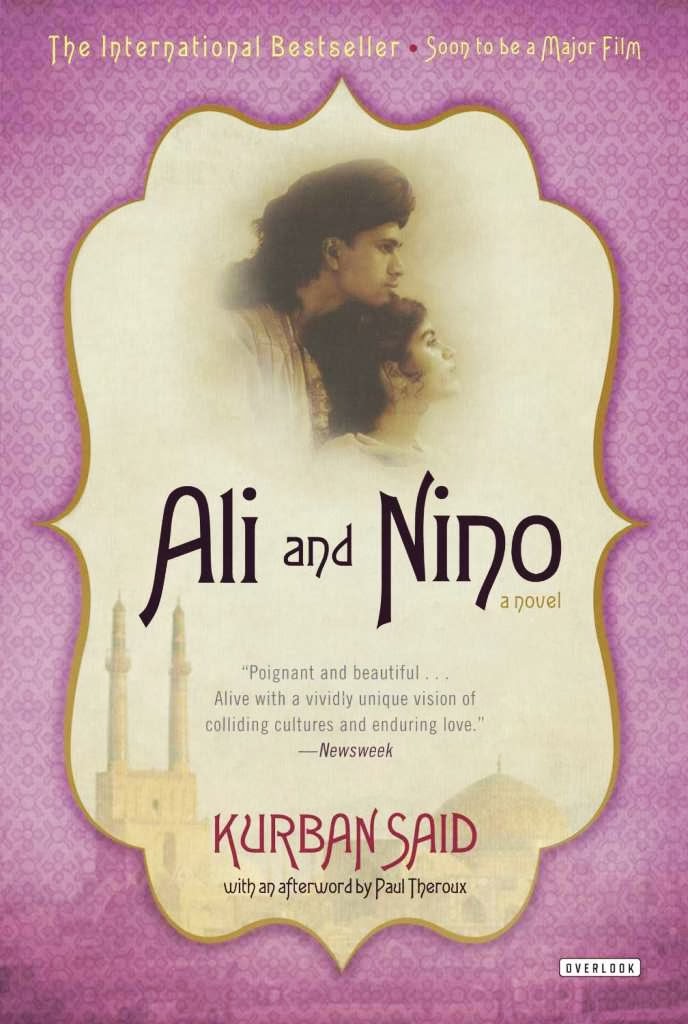Today Europe and the Orient seem irreconcilable worlds because of their conflicting cultures. Nonetheless there are places where Christians, Muslims and Jews used to live together more or less peacefully in the past, for instance the Caucasus region. Armenia, Azerbaijan, Georgia, and the Caucasian territories of the Russian Federation build the bridge between East and West. The accelerated growth of European economy during the past two centuries has constantly widened the gap and made people there feel torn between the old Asian concepts of life deeply rooted in Islam and the new secular lifestyle of Europe as shows the novel Ali and Nino by Kurban Said which I’m reviewing today.
Kurban Said is a pseudonym under which two German-language novels have been published, namely Ali and Nino (Ali und Nino: 1937) and The Girl from the Golden Horn (Das Mädchen vom Goldenen Horn: 1938). Up to this day nobody knows for certain who was the real person hiding behind it, but three possible authors have been made out. First of all there is the Austrian Baroness Elfriede Ehrenfels von Bodmershof (1894-1982) who signed the publishing contract and registered the copyright. In 1944, however, rumour spread that Lev Nussimbaum (1905-1942), better known under his pen name Essad Bey, was the true author of the novels and today it’s widely accepted that the German-language writer originating from Baku in Azerbaijan must have been their co-author at least. In the early 1970s claims were made that the Azeri writer Yusif Vazir Chamanzaminli (Yusif Vəzir Çəmənzəminli: 1887-1942) collaborated with Essad Bey on Ali and Nino which is supported by some scholars. The case of Kurban Said is investigated in the Dutch documentary Alias Kurban Said by Jos de Putter released in 2004 and in the bestselling biography of Essad Bey by Tom Reiss titled The Orientalist: Solving the Mystery of a Strange and Dangerous Life which came out in 2005.
The novel Ali and Nino begins with Ali Khan Shirvanshir’s memory of a geography class in 1909. A teacher of the Russian high school in Baku, Azerbaijan (then part of the Russian Empire) talks about the dispute of scholars regarding the dividing line between Europe and Asia in Transcaucasia. Five years later Ali is a young man of nineteen and in love with beautiful Nino Kipiani whom he knows since childhood. He is the son of a notable Muslim family and Nino is the seventeen-year-old daughter of a newly rich Christian Georgian family. During the summer holidays after Ali’s graduation from high school the two get secretly engaged. World War I breaks out and plunges Europe into chaos, but Ali doesn’t intend to fight for the Russian Empire. It isn’t his war. Some months later he asks Nino’s father for her hand, but he refuses at first and changes his mind only after the mediation of Ali’s older Armenian friend Melik Nachararyan. The wedding day is already close, when Ali is informed one night that Nachararyan kidnapped Nino. Tradition of honour requires that Ali finds the fugitives and kills them. He chases after them, but he only kills Nachararyan and spares Nino. Now Ali has to hide from the Nachararyan clan to escape the vendetta and from the Russian police. After several months Nino visits Ali in his refuge in Daghestan where they get married and lead a happy life in poverty until the Russian imperial authorities quit Azerbaijan following the Bolshevik revolution of 1917. Ali and Nino can finally return to Baku, but after a short fight for the country’s independence in which Ali too takes up arms they have to flee. In Persian exile Nino depresses in the conservative Islamic environment which confines her to the harem and the company of women with whom she has nothing in common. Ali on the other hand feels in his cultural element, but after a moment of religious ecstasy he realizes how much he misses Azerbaijan and her multi-ethnic life. As soon as Baku is taken by Turkish troops and put under British protectorate Ali and Nino return. Azerbaijan is independent now and the cross-cultural couple plays an important role as liaison with European representatives present in Baku. Alas the dream of independence doesn’t last long because the Bolsheviks already reach for Azerbaijan... and her oil.
Ali and Nino is the first-person narrative of Ali Khan Shirvanshir spanning the turbulent years between 1914 and 1920, thus from the dawn of World War I and the Bolshevik revolution in Russia until the end of the temporarily independent Azerbaijan. The crucial period in the country’s history is inseparably interweaved with the personal fate of the two young protagonists whose love story serves to show cultural differences between Muslims and Christians as well as common traditions. Ali represents Asia and the traditional ways of life, thus adherence to the past, while Nino stands for Europe and progress, thus a future-oriented attitude. Consequently, Ali chases after Nachararyan’s car on the back of a legendary Karabakh horse and uses a dagger to kill his opponent. Nino, on the other hand, enjoys the ample social life and amenities of the western world. The novel has an unusually rich plot with many unexpected turns, but exciting and quick scenes are always followed by more contemplative ones acquainting the reader with the narrator’s observations, recollections and reflections. Language and style of the novel are engaging and easy to follow although many of the touched topics are complex and unfamiliar to a western audience.
All in all, I enjoyed reading Ali and Nino by Kurban Said very much since it allowed me another glimpse into the Islamic ways and the difficulties to reconcile them with a modern – western – world without sacrificing the own cultural identity. Since its publication in 1937 the novel has lost nothing of its power and message as proves the fact that it’s currently being adapted for the screen. At any rate I recommend it for reading.








